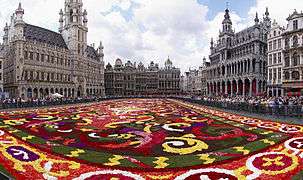Grand Place
| Grand-Place, Brussels | |
|---|---|
| Name as inscribed on the World Heritage List | |
|
The Grand Place; the Town Hall is at the left. | |
| Type | Cultural |
| Criteria | ii, iv |
| Reference | 857 |
| UNESCO region | Europe and North America |
| Inscription history | |
| Inscription | 1998 (22nd Session) |
The Grand Place (French, pronounced: [ɡʁɑ̃ plas]; also used in English[1]) or Grote Markt (Dutch, pronounced [ˌɣroːtə ˈmɑrkt]) is the central square of Brussels. It is surrounded by opulent guildhalls and two larger edifices, the city's Town Hall, and the Breadhouse (French: Maison du Roi, Dutch: Broodhuis) building containing the Museum of the City of Brussels. The square is the most important tourist destination and most memorable landmark in Brussels. It measures 68 by 110 metres (223 by 361 ft), and it is a UNESCO World Heritage Site.[2]
History

Early history
In the 10th century, Charles, Duke of Lower Lorraine constructed a fort on Saint-Géry Island, the furthest inland point at which the Senne river was still navigable. This was the seed of what would become Brussels. By the end of the 11th century, an open-air marketplace was set up on a dried-up marsh near the fort that was surrounded by sandbanks. The market was called the Nedermerckt, or Lower Market.[3]
The market likely developed around the same time as the commercial development of Brussels. A document from 1174 mentions a lower market (Latin: forum inferius) not far from the port on the Senne river. The market was well situated along the Causeway (Dutch: Steenweg), an important commercial road which connected the prosperous regions of the Rhineland and the County of Flanders.
At the beginning of the 13th century, three indoor markets were built on the northern edge of the Grand Place; a meat market, a bread market and a cloth market.[3] These buildings, which belonged to the Duke of Brabant, allowed the wares to be showcased even in bad weather, but also allowed the Dukes to keep track of the storage and sale of goods, in order to collect taxes. Other buildings, made of wood or stone, enclosed the Grand Place.
Rise in importance

Improvements to the Grand Place from the 14th century onwards would mark the rise in importance of local merchants and tradesmen relative to the nobility. Short on money, the Duke transferred control of mills and commerce to the local authorities. The city of Brussels, as with the neighbouring cities of Mechelen and Leuven constructed a large indoor cloth market to the south of the square. At this point, the square was still haphazardly laid out, and the buildings along the edges had a motley tangle of gardens and irregular additions.[3] The city expropriated and demolished a number of buildings that clogged the Grand Place, and formally defined the edges of the square.
The Brussels City Hall was built on the south side of the square in stages between 1401 and 1455, and made the Grand Place the seat of municipal power. It towers 96 metres (315 ft) high, and is capped by a 4-metre (12 ft) statue of Saint Michael slaying a demon or devil. To counter this symbol of municipal power, from 1504 to 1536 the Duke of Brabant built a large building across from the city hall as symbol of ducal power.[3] It was built on the site of the first cloth and bread markets, which were no longer in use, and it became known as the King's House (Middle Dutch: 's Conincxhuys), although no king has ever lived there. It is currently known as the Maison du roi (King's House) in French, though in Dutch it continues to be called the Broodhuis (Breadhouse), after the market whose place it took. Wealthy merchants and the increasingly powerful guilds of Brussels built houses around the edge of the square.
Destruction and rebuilding
On August 13, 1695, a 70,000-strong French army under Marshal François de Neufville, duc de Villeroy, began a bombardment of Brussels in an effort to draw the League of Augsburg's forces away from their siege on French-held Namur in what is now southern Belgium. The French launched a massive bombardment of the mostly defenseless city centre with cannons and mortars, setting it on fire and flattening the majority of the Grand Place and the surrounding city. Only the stone shell of the town hall and a few fragments of other buildings remained standing. That the town hall survived at all is ironic, as it was the principal target of the artillery fire.

The square was rebuilt in the following four years by the city's guilds. Their efforts were regulated by the city councillors and the Governor of Brussels, who required that their plans be submitted to the authorities for their approval. This helped to deliver a remarkably harmonious layout for the rebuilt Grand Place, despite the ostensibly clashing combination of Gothic, Baroque and Louis XIV styles.
In the late 18th century, Brabant Revolutionaries sacked the Grand Place, destroying statues of nobility and symbols of Christianity.[2] The guildhalls were seized by the state and sold. The buildings were neglected and left in poor condition, with their façades painted, stuccoed and damaged by pollution. In the late 19th century, mayor Charles Buls had the Grand Place returned to its former splendour, with buildings being reconstructed or restored.
19th and 20th century
In 1885, the Belgian Labour Party (POB-BWP), the first socialist party in Belgium, was founded during a meeting on the Grand Place.
At the start of World War I, as refugees flooded Brussels, the Grand Place was filled with military and civilian casualties.[4] Town Hall served as a makeshift hospital.[4] On August 20, 1914, at 2pm, the occupying German army arrived at the Grand Place and set up field kitchens.[4] The occupiers hoisted a German flag at the left side of the Town Hall.[4]
The Grand Place continued to serve as a market until November 19, 1959, and it is still called the Great Market or Grote Markt in Dutch. Neighbouring streets still reflect the area's origins, named after the sellers of butter, cheese, herring, coal and so on. The Grand Place was named by UNESCO as a World Heritage Site in 1998. One of the houses was owned by the brewers' guild, and is now the home of a brewers' museum.
The Grand Place was voted the most beautiful square in Europe in 2010. A survey by a Dutch website[5] asked its users to rate different squares across Europe. Moscow’s Red Square and the Place Stanislas in Nancy, France, took second and third place.
Flower carpet

Every two years in August, an enormous "flower carpet" is set up in the Grand Place for a few days. A million colourful begonias are set up in patterns, and the display covers a full 24 by 77 metres (79 by 253 ft), for area total of 1,800 square metres (19,000 sq ft).[3] The first flower carpet was made in 1971, and due to its popularity, the tradition continued, with the flower carpet attracting a large number of tourists.[6]
In popular culture

- The second and third series of the BBC television series Secret Army were filmed here in 1978 and 1979, specifically around the building that is now Maxim's restaurant.
References
- ↑ In this case, the French word place is a "false friend", and the correct counterparts in English are "plaza" or "town square".
- 1 2 "La Grande-Place de Bruxelles" (in French). bruNET. May 17, 2007. Retrieved October 9, 2009.
- 1 2 3 4 5 "History of the Grand Place of Brussels". Commune Libre de l'Îlot Sacré. Retrieved August 25, 2009.
- 1 2 3 4 "Occupation of Brussels on 20 August 1914". City of Brussels. City of Brussels. Retrieved 3 September 2016.
- ↑ "Most Beautiful Squares in Europe". stedentripper.com. Retrieved 2010-11-23.
- ↑ "Giant Flower Carpet on the Grand Place in Brussels Pays Tribute to Turkish Immigrants". International Business Times UK. Retrieved 2016-02-06.
External links
| Wikimedia Commons has media related to Grand Place (Brussels). |
- UNESCO page related to the Grand Place
- Virtual visit, photos and webcam of the Grand Place
- Brussels' Flowercarpet official website
- Visit the Grand Place in 360° Photosphere
- Live WebCam
Coordinates: 50°50′48″N 4°21′09″E / 50.8467°N 4.3525°E

